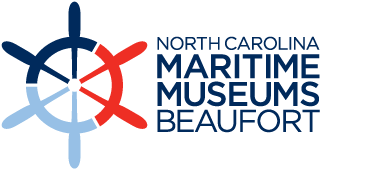HOURS
The N.C. Maritime Museum, located at 315 Front St. in downtown Beaufort, is open year-round on the following schedule:
Monday – Saturday: 10 a.m. to 5 p.m.
Sunday: noon to 5 p.m.
We are closed on Thanksgiving Day; Dec. 24, 25 and 26 for the Christmas Holiday; and New Year’s Day.
Admission is free. Donations are appreciated.
The Harvey W. Smith Watercraft Center, located on the waterfront across the street from the museum, is open Monday to Saturday from 10 a.m. to 5 p.m. and Sundays from noon to 5 p.m.
There’s always something happening at the N.C. Maritime Museum!
The North Carolina Maritime Museum in Beaufort reflects coastal life and interprets lighthouses and lifesaving stations, the seafood industry, motorboats, and more. Studies in marine life, science, and ecology are available for all ages. The Beaufort museum is the repository for artifacts from Blackbeard’s wrecked flagship, Queen Anne’s Revenge, among them cannons, grenades, belt buckles and beads. The Harvey W. Smith Watercraft Center teaches boatbuilding for all ages.
The Harvey W. Smith Watercraft Center
 In 1980, Harvey W. Smith’s widow Mrs. Evelyn Smith donated property on Front Street for the building of a new museum to replace the Hampton Mariners Museum That facility had outgrown its location on Turner Street. At that time, first time museum curator Charles R. McNeill was offered anything the museum could use by Mrs. Smith from her late husband’s maritime collection. That was the beginning of the North Carolina Maritime Museum as we know it today.
In 1980, Harvey W. Smith’s widow Mrs. Evelyn Smith donated property on Front Street for the building of a new museum to replace the Hampton Mariners Museum That facility had outgrown its location on Turner Street. At that time, first time museum curator Charles R. McNeill was offered anything the museum could use by Mrs. Smith from her late husband’s maritime collection. That was the beginning of the North Carolina Maritime Museum as we know it today.
The museum’s Watercraft Center sits on Taylors Creek, across from the North Carolina Maritime Museum. Today, locals, visitors and boaters alike are encouraged to watch, and take boatbuilding courses offered throughout the year for all skill levels.
North Carolina Department of Natural and Cultural Resources
The museum is a division of the N.C. Department of Natural and Cultural Resources. NCDNCR is the state agency with a vision to be the leader in using the state’s natural and cultural resources to build the social, cultural, educational and economic future of North Carolina. NCDNCR’s mission is to improve the quality of life in our state by creating opportunities to experience excellence in the arts, history, libraries and nature by stimulating learning, inspiring creativity, preserving the state’s history, conserving the state’s natural heritage, encouraging recreation and cultural tourism, and promoting economic development.
NCDNCR includes 27 historic sites, seven history museums, two art museums, two science museums, three aquariums and Jennette’s Pier, 39 state parks and recreation areas, the N.C. Zoo, the nation’s first state-supported Symphony Orchestra, the State Library, the State Archives, the N.C. Arts Council, State Preservation Office and the Office of State Archaeology, along with the Division of Land and Water Stewardship.
